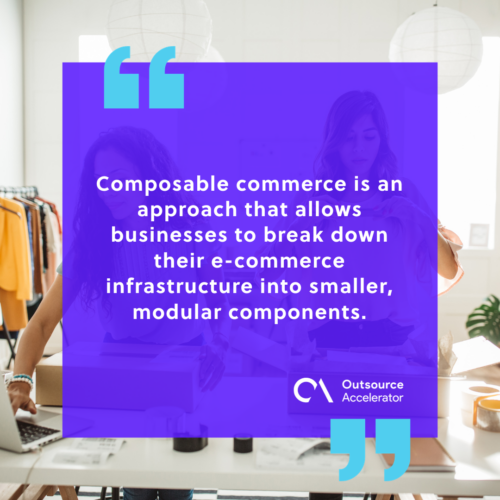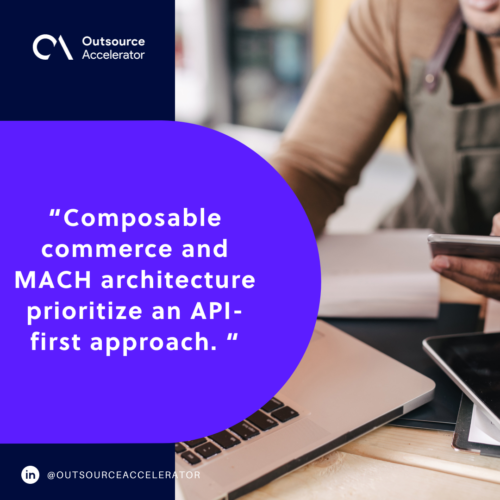Composable commerce: Definition and benefits

In the world of e-commerce, staying ahead of the curve is not just an option; it’s a necessity.
The term ‘composable commerce’ has been making waves lately, promising a new business model. But what exactly is composable commerce, and why should you care?
In this article, we’ll delve into composable commerce, its benefits, what you should consider when developing it, and how it will shape the future of businesses.
What is composable commerce?
Imagine your e-commerce platform as a set of building blocks. Each block represents a specific function or feature, such as:
- Product catalog
- Shopping cart
- Payment processing
- Customer reviews
Picture yourself rearranging these blocks effortlessly, like building with LEGO bricks. That’s the essence of composable commerce.
Composable commerce is an approach that allows businesses to break down their e-commerce infrastructure into smaller, modular components. These components can be assembled and customized to create a unique and flexible digital commerce experience.
It’s all about empowering you to adapt quickly to changing market conditions and customer demands.

Composable commerce vs. Headless commerce
Before diving deeper, let’s address a common question – how does composable commerce differ from headless commerce?
Both concepts aim to provide flexibility but do so in distinct ways.
Headless commerce separates the front end (what customers see) from the back end (where data is processed). It offers flexibility in designing customer interfaces but may lock you into specific features and functionality.
While composable commerce takes flexibility to the next level by dividing the entire e-commerce system into interchangeable parts, giving you more control and freedom.
Composable commerce vs. MACH architecture
Composable commerce and MACH architecture are two distinct but related concepts in e-commerce and digital business.
Let’s break down their connection:
Microservices
Both composable commerce and the MACH architecture emphasize the use of microservices.
In composable commerce, various e-commerce functions are divided into modular components, making it easy to assemble and reassemble them as needed.
Similarly, the “M” in MACH stands for “Microservices,” which involves breaking down a monolithic system into small, independent services.
API-first approach
Composable commerce and MACH architecture prioritize an API-first approach. Composable commerce relies on robust APIs to integrate various services and components.
The “A” in MACH stands for “API-First,” underlining the importance of APIs in enabling seamless communication between different parts of an e-commerce system.

Flexibility and adaptability
Composable commerce and the MACH architecture are designed to be flexible and adaptable.
Composable commerce allows businesses to easily compose and recompose their e-commerce solutions to meet changing requirements.
The MACH architecture offers similar flexibility by allowing businesses to add, remove, or replace individual microservices without disrupting the entire system.
Cloud-Native
The “C” in MACH stands for “Cloud-Native,” highlighting the compatibility of MACH architecture with cloud-based infrastructures. Composable commerce also aligns with this concept, as many composable commerce solutions are designed to leverage cloud services.
Benefits of composable commerce
Let’s explore the benefits that come with adopting a composable commerce approach:
Empowering business agility
In today’s digital landscape, adaptability is key to success. Composable commerce empowers your business to respond quickly to market shifts.
With composable commerce, you’re not bound by rigid systems; you’re free to evolve.
Scalability and customization
A single approach seldom suits everyone in online commerce. Composable commerce allows you to scale your platform effortlessly as your business grows.
Whether a startup or an established enterprise, you can tailor your e-commerce solution to your unique requirements. It’s like having a wardrobe with adjustable shelves that expand as your clothing collection grows.
Enhanced customer experience
Customers anticipate a shopping experience that is both smooth and tailored to their preferences. Composable commerce enables you to create user-centric interfaces and features.
You can craft product recommendations, implement chatbots, and optimize the checkout process to enhance the customer journey.
It’s like having a personal shopper who understands your preferences thoroughly.
Cost-efficiency
Traditional e-commerce platforms often come with hefty price tags and ongoing licensing fees.
Composable commerce allows you to optimize costs by only paying for the components you use. It’s similar to paying for individual ingredients rather than ordering an entire fixed-course meal at a restaurant.
Things to consider when developing your composable commerce
Before fully embracing composable commerce, take note of these crucial factors:
Integration and compatibility
Ensure that the components you choose can seamlessly integrate with your systems in place. Compatibility issues can lead to disruptions and inefficiencies in your e-commerce operations.
Security first
Make security a top priority. Implement robust security measures for each component to protect your business and customer data effectively.

Skill development
Invest in training and skill development for your team. Equipping them with the knowledge to manage composable commerce will pay off in the long run.
Ongoing support
Plan for ongoing support and maintenance. Regularly update and optimize your composable commerce setup to stay competitive.
The future of composable commerce
So, what does the future hold for composable commerce? As technology advances, composable commerce is likely to become even more prevalent.
We can expect greater standardization of components, making it easier for businesses of all sizes to adopt this approach.
Composable commerce offers businesses a dynamic and flexible way to thrive in the digital marketplace.







 Independent
Independent




